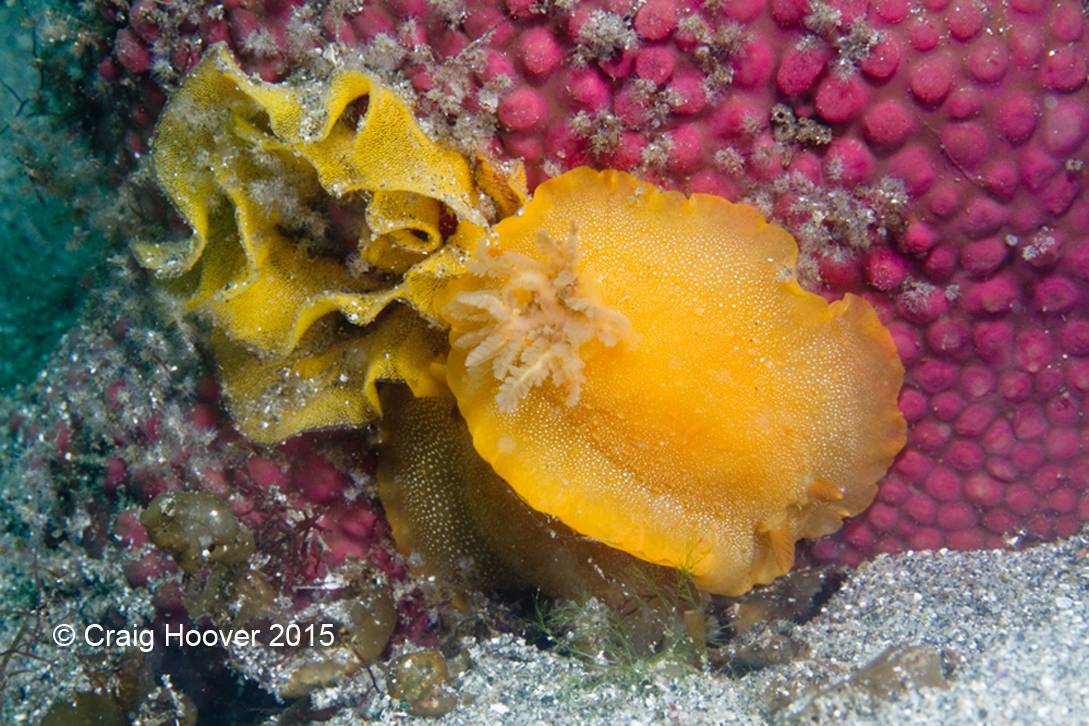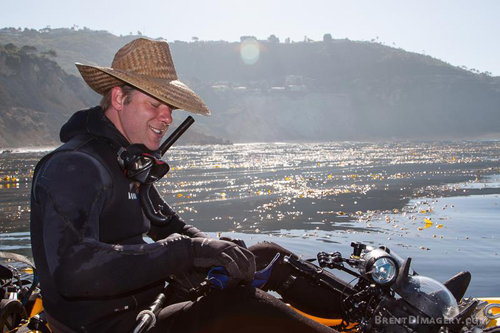 |
Doriopsilla davebehrensi
Image courtesy of Craig HooverBahia de Los Angeles, Baja California
Doriopsilla davebehrensi (Hoover, Lindsay, Goddard & Valdes, 2015)
We have yet another revision within the genus Doriopsilla from the temperate north-eastern Pacific. Historically, D. albopunctata was thought to have a population in Bahia de Los Angeles in the Gulf of California and another along the outer Pacific (Gosliner Schaefer & Millen, 1999). These two populations have been shown to be genetically and morphologically distinct (Hoover, Lindsay, Goddard & Valdes, 2015). We name the species found at Bahia de Los Angeles Doriopsilla davebehrensi to honor the seminal contributions Dave has made to the field of malacological research.
Doriopsilla davebehrensi is relatively large and round with a narrow mantle margin. Animals reach 3.5 centimeters in size. The dorsum ranges in color from yellow to orange and has many tubercles, evenly spaced throughout the central portion, and becoming sparser towards the margin. The dorsum is covered with numerous white spots which may or may not be found on the tubercles. White spots found on tubercles are relatively faint. The gill is yellowish, orangish, or off-white; lighter in color than the dorsum, the gill has five leaves. The tips of the rhinophores appear slightly lighter in color than the rhinophores when viewed from a dorsal-posterior angle.
Doriopsilla davebehrensi is currently known from multiple animals found at Bahia de Los Angeles and a single animal from Newport Bay in Southern California. The individual observed in Newport was found in spring of 2014 during a local warming trend that lead to the moderate El Nino of 2014-2015.
Key to pseudocryptic Doriopsillas in the temperate north-eastern Pacific:
1. White spots found only on top of the tubercles-------------------------------D. fulva
1' White spots found between tubercles----------------------------------2
2. Gill the same color as the dorsal margin--------------------------------------3
2' Gill not the same color as the dorsal margin----------------------------4
3. When fully extended, gill less than half the width of the dorsum---------------D. gemela
3' When fully extended, gill half the width of the dorsum or greater-------D. bertschi
4. Tubercles with prominent white spots on top---------------------------------D. albopunctata
4' Tubercles with faint white spots on top--------------------------------D. davebehrensi
References
Hoover C, Lindsay T, Goddard H R, Valdes A. 2015. Seeing double: pseudocryptic diversity in the Doriopsilla albopunctata-Doriopsilla gemela species complex of the north-eastern Pacific.
Zoologica Scripta, DOI: 10.1111/zsc.12123.
Gosliner, T. M., Schaefer, M. C. & Millen, S. V. (1999). A new species of Doriopsilla (Nudibranchia: Dendrodorididae) from the Pacific coast of North America, including a comparison with Doriopsilla albopunctata (Cooper, 1863). The Veliger, 42, 201-210.
Craig Hoover
Cal Poly at Pomona, Calif
June, 2015
Send Craig email at crghvr@yahoo.com
Craig Hoover on location
 |
Hi branchers. My name is Craig Hoover. I am a graduate student in the lab of Dr. Angel Valdes at Cal Poly Pomona. My M.S. thesis examines biogeographical patterns in sea slugs that range through both the temperate north-eastern Pacific and the Sea of Cortez using molecular techniques. In this process, we have discovered and named the new species, Doriopsilla davebehrensi. Here is an autobiographical account of what led me to study these animals and name this one in honor of Dave. My explorations of the aquatic realm began when I was a child fishing in the cold and swift waters of rivers in the Sierra Nevada Mountains. I became a snorkeler and free diver by age ten, and discovered the wonders of marine life as a teen. I began free diving Malibu in my 20s, and saw my first nudibranch, a Spanish shawl, at Leo Carillo State Park. What a glorious little creature! I learned to scuba dive a year later, in 2004, and continued exploring California's coast each weekend. In 2005, I opened a college catalog to see what would be required to realize a career merging education with marine biology. I traced my finger through the pages all the way back to Introductory Algebra. As a guitar teacher 27 years old, the process seemed daunting, but I have always met challenges with enthusiasm because each brings me closer to my goal. |
My fascination with nudibranchs became a regular hobby in 2009 when I found an old worn original copy of Pacific Coast Nudibranchs (Behrens 1980) at the back shelf of a shelf in ALOHA divers. Though it was a 'shop copy,' the price tag was still there and I talked the owner into selling it to me. This copy still holds a treasured spot on my shelf.
Porostomes are especially interesting. This genus is abundant in Malibu, and a certain yellow-gilled porostome was listed as undescribed (Behrens 1980). Perhaps I have a contribution to make, I thought, as I filled notebooks with detailed observations. Years later, through the help of Jeff Goddard, Angel Valdes, and Hans Bertsch, this has come true. I am happy to continue to follow this path among such excellent company, and name Doriopsilla davebehrensi in honor of the man whose work originally inspired me to become a brancher.
Behrens D. W. 1980. Pacific Coast Nudibranchs: A Guide to the Opisthobranchs of the Northeastern Pacific. Sea Challengers, 1851 Don Avenue, Los Osos, California 93402.

|
